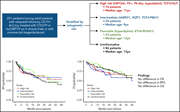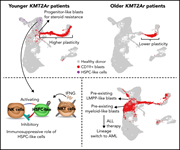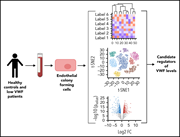Issue Archive
Table of Contents
BLOOD COMMENTARIES
PLENARY PAPER
Disrupting the adult globin promoter alleviates promoter competition and reactivates fetal globin gene expression
Hereditary persistence of fetal hemoglobin (HPFH) ameliorates the severity of sickle cell disease and β-thalassemias when coinherited. In this Plenary Paper, Topfer and colleagues address the long-standing question of how deletions of the adult β-globin (HBB) gene cluster cause HPFH. Using directed mutagenesis in cell lines and primary progenitor cells, they provide proof that increased hemoglobin F arises because the human γ-globin gene promoter outcompetes the HBB promoter for interactions with the locus control region that regulates globin expression.
BLOOD SPOTLIGHT
Genotoxic aldehydes in the hematopoietic system
In this Spotlight review, Wang and colleagues summarize compelling genetic, biochemical, and functional evidence for the threat that endogenously produced aldehydes pose for hematopoiesis. These reactive metabolites drive much of the genotoxic damage underpinning hematopoietic stem cell attrition in Fanconi anemia and other DNA-repair deficiency states resulting in bone marrow failure.
REVIEW ARTICLE
Neutrophils in acute inflammation: current concepts and translational implications
Margraf et al review recent advances in knowledge about neutrophil biology with a particular focus on translational opportunities for addressing acute inflammatory conditions.
CLINICAL TRIALS AND OBSERVATIONS
Oral azacitidine prolongs survival of patients with AML in remission independently of measurable residual disease status
Clinical Trials & Observations
Roboz and colleagues report on a secondary analysis of minimal residual disease (MRD) data from the randomized trial of oral azacitidine versus placebo as maintenance in first remission of acute myeloid leukemia (AML) after remission induction therapy. The overall and relapse-free survival benefit from azacitidine is independent of the post-induction presence or absence of MRD. The median duration of MRD-negativity is 6 months longer, and for patients with detectable MRD at randomization, conversion to MRD-negativity was double with azacitidine.
IMMUNOBIOLOGY AND IMMUNOTHERAPY
Impact of high-risk cytogenetics on outcomes for children and young adults receiving CD19-directed CAR T-cell therapy
Clinical Trials & Observations
Cytogenetic-based risk stratification is central to care of pediatric and young adult patients with B-cell precursor acute lymphoblastic leukemia (ALL). Leahy and colleagues investigate whether genetic risks are prognostic for outcomes in 231 patients with relapsed or refractory ALL receiving chimeric antigen receptor (CAR) T-cell therapy. Complete remission rates (overall 94%) and 2-year relapse-free survival rates are similar regardless of cytogenetic category, reinforcing the curative potential of cellular immunotherapy for all patients with B-cell ALL.
LYMPHOID NEOPLASIA
Single-cell multiomics reveals increased plasticity, resistant populations, and stem-cell–like blasts in KMT2A-rearranged leukemia
MYELOID NEOPLASIA
Structural racism is a mediator of disparities in acute myeloid leukemia outcomes
Clinical Trials & Observations
There is a persistent and unexplained racial disparity in outcomes for patients with serious hematological conditions in the United States and other countries. Analyzing a multicenter retrospective cohort of 822 patients with acute myeloid leukemia, Abraham et al find significantly increased hazard ratios for death when non-Hispanic Black and Hispanic patients are compared to White patients. Validated proxies for structural racism are shown to be stronger mediators of these survival disparities than molecular features, comorbidities, healthcare access, and treatment.
PLATELETS AND THROMBOPOIESIS
CRLF3 plays a key role in the final stage of platelet genesis and is a potential therapeutic target for thrombocythemia
How platelets are finally produced in vivo remains contentious. In this translational research, Bennett et al describe thrombopoiesis as a 3-step process and identify cytokine receptor-like factor 3 (Crlf3) as a novel regulator of preplatelet maturation. They also explore the potential of Crlf3 inhibition to lower platelet counts in essential thrombocythemia in a murine model of this disease.
THROMBOSIS AND HEMOSTASIS
LETTER TO BLOOD
Single-cell analysis reveals immune dysfunction from the earliest stages of CLL that can be reversed by ibrutinib
BLOOD WORK
ERRATA
-
Cover Image
Cover Image
![issue cover]()
A Crlf3−/ − megakaryocyte forming multiple proplatelets (long cytoskeletal protrusions that form platelets) imaged by fluorescence microscopy using antibodies against CD41 (green) and the DNA stain DAPI (blue). See the article by Bennett et al on page 2227.
- PDF Icon Front MatterFront Matter
- PDF Icon Table of ContentsTable of Contents
- PDF Icon Back MatterBack Matter
- PDF Icon Editorial BoardEditorial Board
Advertisement intended for health care professionals
Email alerts
Advertisement intended for health care professionals














Promoter competition in globin gene control